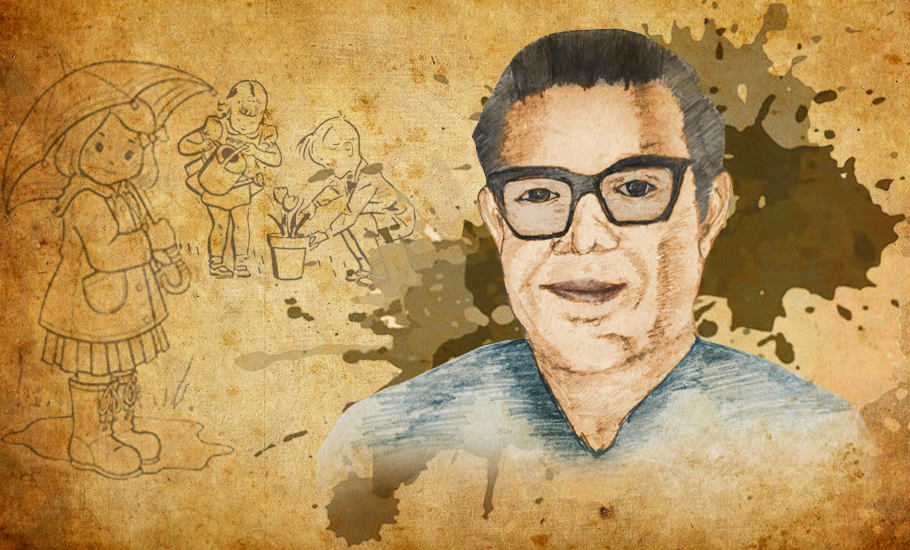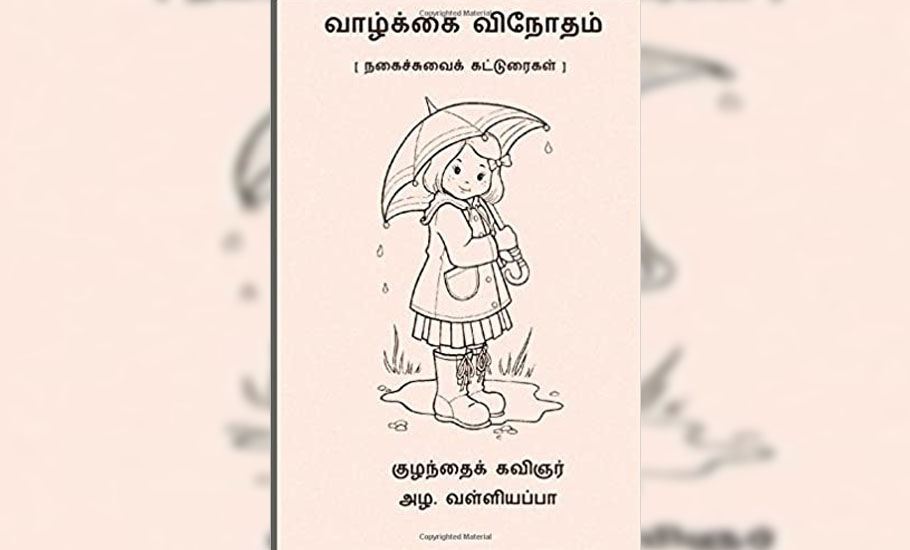
- Home
- News
- Analysis
- States
- Perspective
- Videos
- Education
- Entertainment
- Elections
- Sports
- Features
- Health
- Budget 2024-25
- Business
- Series
- Bishnoi's Men
- NEET TANGLE
- Economy Series
- Earth Day
- Kashmir’s Frozen Turbulence
- India@75
- The legend of Ramjanmabhoomi
- Liberalisation@30
- How to tame a dragon
- Celebrating biodiversity
- Farm Matters
- 50 days of solitude
- Bringing Migrants Home
- Budget 2020
- Jharkhand Votes
- The Federal Investigates
- The Federal Impact
- Vanishing Sand
- Gandhi @ 150
- Andhra Today
- Field report
- Operation Gulmarg
- Pandemic @1 Mn in India
- The Federal Year-End
- The Zero Year
- Premium
- Science
- Brand studio
- Newsletter
- Home
- NewsNews
- Analysis
- StatesStates
- PerspectivePerspective
- VideosVideos
- Entertainment
- ElectionsElections
- Sports
- Features
- BusinessBusiness
- Premium
- Loading...
Premium - India-Canada ties

Tamil literature: Where did all the children’s writers go?

In 1940, a young man of 18 entered a small magazine office in Chennai looking for a cashier’s job. A year later, he came out of the same office with a wealth of accomplishments, albeit as a writer. The magazine was called Sakthi, run by Vai Govindan, a stalwart in the Tamil publishing industry. And the young man was none other than Al Valliappa, popularly known as ‘Kuzhandai...
In 1940, a young man of 18 entered a small magazine office in Chennai looking for a cashier’s job. A year later, he came out of the same office with a wealth of accomplishments, albeit as a writer.
The magazine was called Sakthi, run by Vai Govindan, a stalwart in the Tamil publishing industry. And the young man was none other than Al Valliappa, popularly known as ‘Kuzhandai Kavignar’ (children’s poet). Although Valliappa went on to land another job in Indian Bank in 1941, he continued to ignite a sense of wonder and awe, hope and excitement in children through his writing for years to come.
Valliappa built on the legacy of Kavimani Desigavinayakam Pillai (1876-1954) who first sowed the seeds of children’s literature in Tamil. Recently, the Tamil Nadu government instituted ‘Kavimani Award’ in Pillai’s memory to encourage writers under the age of 18. The announcement, which incidentally comes in Valliappa’s birth centenary year, raises hope to see more and more writers coming forward to take up the challenge, just like he himself did decades back.
According to author and literary critic MK Srinivasan, writing for children evolved as a literary genre in Tamil only because of Kavimani and Al Valliappa – the two pioneers of 20th century Tamil poetry. While Kavimani started writing for children in 1901 and made rich contributions to modern poetry for young boys and girls, Valliappa sort of picked up from where Kavimani had left and continued the legacy.
“Valliappa, like Walter De La Mare, has written many moon-soaked lyrics, rhymes and narrative poems for children,” writes Srinivasan in a 1978 issue of the Indian Literature, a journal published by Sahitya Akademi.
He adds that after Kavimani, Valliappa contributed significantly to children’s writing. Interestingly, even before he became a popular children’s writer, Valliappa had decided to write only for children.
Kavimani himself greeted Valliappa with the following benediction while releasing the latter’s Malarum Ullam, a collection of 135 songs in 1954:
“May, Valliappa, the magician-laureate, thrive evermore, enabling children to read and enjoy his songs morning and evening every day,” notes prof KR Srinivasa Iyengar, former vice-chancellor of Andhra University and a fellow of Sahitya Akademi, while writing a foreword to Valliappa’s book, Sirikkum Pookkal, published in 1986.
From Christ to children
According to Valliappa, the first Tamil magazine for adults itself rolled out in 1831. It was only by 1840 that magazines for children started to be published.

Christian missionaries, who made most educational efforts, also carried out the work of popularising children’s literature.
In 1840, Baladeepikai, a children’s quarterly magazine was published from Nagercoil (now in Kanyakumari district). Then came Sirupillaiyin Nesathozhan published from Palayamkottai. In 1889, Baaliyar Nesan was published from Jaffna, Sri Lanka. All these magazines were published by Christian missionaries. But they did not survive for a long time.
“In 1891, a new initiative was taken up. Instead of publishing a magazine exclusively for kids, Viveka Chinthamani, a magazine meant for adults, started dedicating some pages for children. The trend was picked up by others like Jana Vinothini, Thamizhar Nesan, Kalaimagal, Ananda Vikatan and Kalki,” Valliappa said in one of his lectures in the 1980s. “But 1918 again saw the publication of children’s magazines – Bala Vinothini, Pokkishabharani, Paappaa Malar, Ambulimama and Balar Malar.”
Whenever there is a critique of children’s literature in Tamil, they include ancient Tamil texts that talk about moral values such as Kondrai Vendhan, Vetri Verkai, Ulaga Needhi, etc. But Valliappa believed that those works should not be included under children’s literature because they propagated ‘regressive’ ideas such as ‘women should not be given equal space’.
According to historian Sugumaran, during its nascent stage, children’s literature in Tamil focused mostly on poems and plays. Then it started to expand to stories and biographies. But now writers have been exploring different genres like folk, fantasy, realism, moral, science, school education, adventure as well as humour.
“During Valliappa’s time, children’s literature mostly revolved around nationalism, spiritualism, love for family and a bit of realism. Now, things are changing. It’s more about gender equality, environmentalism, sexuality, etc” says Sugumaran.
A banker-turned-writer
Born on November 7, 1922, to Alagappa Chettiar and Umaiyal Aachi at Rayavaram, a village in Pudukkottai, Valliappa started to pen poems at the age of 13.
After completing his education, he moved to Chennai in 1940 and joined the magazine Sakthi, as a cashier. The magazine was run under the editorship of Thingalur Jagathratchaga Ranganathan, who was fondly referred as ‘Thi Ja Ra’. It was Ranganathan who encouraged Valliappa to write for the magazine.
Later after joining the Indian Bank, Valliappa continued to write articles, poems and short stories. He went on to serve as an honorary editor in various magazines – Pasamalar, Damaram and Sangu. He also edited Pooncholai and Gokulam.
In 1950, Valliappa founded the ‘Association of Tamil Writers for Children’ (which became defunct in 2000). ‘Sakthi’ Vai Govindan served as its first chief.
In his lifetime, he has written nearly 60 books. One of his books Nam Nadhigal, which introduces rivers of South India to children has been translated into 14 Indian languages by the National Book Trust.
“Malarum Ullam, Valliappa’s first collection of 23 songs, came out in 1944. The simplicity in narration elevates the thoughts. The rhythmic smoothness of his writing became an instant hit among readers,” says prof Iyengar.

“More poems were added to the collection later, taking the number to 135 songs. It was published in 1954. An equally sumptuous second series came out in 1961. Both volumes carried numerous illustrations, giving flight to the children’s imaginations,” he adds.
Then in the years that followed, Valliappa produced work in every possible genre – from fiction to biography and non-fiction accompanied by black and white illustrations. Those works opened new vistas for the children, says Iyengar.
Poetry is generally distinguished from prose in its order of words. This keen sense of rhythm, the recurring pattern and the expectant balance constituting the rhymes appeal to the child’s ear and thus stay in their mind forever, adds Srinivasan.
“A poet for children must be a master of the language which not only suits, but also captivates the children. Al Valliappa’s rhymes appealed to the children. It is beyond doubt that it was a feast of wordplay for the children.”
While Valliappa died on March 16, 1989, he passed on the baton to writers like P Thooran, R Venkatraman, Thambi Seenivasan, ‘Kalvi’ Gopalakrishnan, Poovannan and many more who continue to write for children. Even then the future of children’s literature in Tamil doesn’t seem too bright.
Where did the writers go
In 1972, the Kuzhandai Ezhuthalar Sangam, founded in 1950 by Valliappa, published Kuzhandhai Ezhuthalargal Yaar Evar (The Who’s Who of Children’s Literature), which listed out the details of 370 writers. A similar exercise in 2019 by children’s writer RV Pathi threw up the names of only 102 writers.
So, where did the writers go? Are they no longer interested in taking up the challenge to ignite the young minds?
“One major reason is the change in the education system,” says Sugumaran.
According to him, the readership in Tamil came down drastically after the 1990s, mainly due to the proliferation of English-medium schools. “Most parents don’t even choose Tamil as a language paper for their wards. This has affected the readership badly.”
During Valliappa’s days, Sugumaran adds, there were nearly 50 children’s magazines in Tamil. “But now there is very little demand for Tamil magazines. So when there is no demand, there is also no scope for new writers to showcase their talent, or to experiment in different genres.”
Prof Iyengar dwells on the eternal question of what it takes to write for children. Contrary to the assumption that one who writes for children should ‘stoop’ to their level, Iyengar believes, one actually needs to rise to the much higher and purer levels of consciousness of children.
“The four elements that constitute the child’s birthright of instinctive or intuitive knowledge are (in Ernest Raymond’s words) eternal wisdom, temporal vision, healing touch and poignant humour,” he writes in the preface of the book, Sirikkum Pookkal. Whether the literary works aimed at children produced today cater to these four needs? Or, what are the common issues addressed?
Udhayasankar, president of the recently formed Tamil Nadu Children Writers’ and Artists’ Association, says more than profit, the literary works aimed at children these days are more entwined in the ‘politics of welfare of children’.

“There is a need for young adult literature in Tamil. We have around 20 regular contributors, including women, for children’s literature. After Valliappa, there was a long gap. A generation of children grew up without tasting children’s literature. Only after 2010, there was a shift in socio-political culture. The generation which missed out on children’s literature now want their kids to be introduced to this genre. So, books are being published accordingly that have fantasy and adventure themes,” he says.
Although there are no exclusive magazines for kids in Tamil language today, there are publishing houses like the Chennai-based Bharathi Puthakalayam that continue to publish children’s literature. At the national level, the Sahitya Akademi has started to recognise children’s writers by awarding the Bal Sahitya Puraskar from 2010 onwards.
Talking about how the association formed in June 2021 intends to help children’s literature grow, Udhayasankar says it has plans to organise readers clubs, camps for adults who write for children besides school children who want to become writers.
The state government’s initiative in this regard will be a welcome move, he adds. “But it should have a proper non-political committee for its effective functioning. It should not become just another school programme.”

